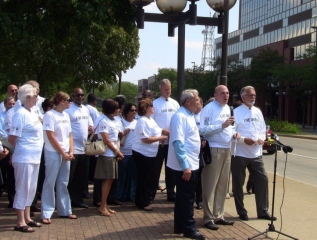Press rlease and photos from the United Way of Allen County:
United Way Leaders Aim High: Workplace Campaign Goal Set at $5 Million
United Way of Allen County leaders are setting the bar high for this year’s annual campaign, establishing a $5 million fundraising goal; last year’s goal was $4.8 million.
“Fort Wayne and Allen County have demonstrated in so many ways over the years what a caring and giving community we are,” said Steve Smith, United Way’s campaign chairperson. “Last year was no exception as United Way’s Campaign met its goal despite the strains that all of us feel from the economy. Encouraged by an overwhelming response to our appeal for more campaign volunteers, we are confident that the community we call home will respond one more time to this new goal. We are determined to involve an ever-expanding number of donors and workers so that cuts to social service agencies need not continue.”
Donations to United Way of Allen County support 63 local social service programs and 37 local partner agencies. Funded services fall into three categories, Basic Needs, Success in School and Family Stability. The services are provided for people in need and include everything from child care to health care, from counseling to scouting, and from literacy instruction to shelter for the homeless. The funds are allocated by volunteers who carefully examine each program and its results.
Smith cited the following examples when explaining that agencies are struggling to meet the needs of local residents:
- United Way helps fund SCAN’s Healthy Families program, which provides one-on-one in-home services to parents of newborn babies where the parents show risk factors for abuse and neglect. The State of Indiana cut funding by $2.4 million for 2010, and in Allen County, that means 250 families will not be served this year.
- United Way partners with several fully accredited local child care centers to provide a sliding fee scale for the children of low-income residents. Currently, the partners report a total waiting list of more than 500 children needing high-quality, low-cost child care.
- Associated Churches Food Bank has seen double-digit increases the last two years in people needing food. In particular, Associated Churches Food Bank sees a great need for bread; the cost to provide more than 20,000 loaves of bread a year to people in need would be a little more than $13,000.
“United Way works to address both long-term and short-term needs in order to get at the root causes of poverty,” said Ron Turpin, United Way board chair. “United Way funds programs that help people get through an immediate crisis, such as homelessness, and also funds programming, such as preparation for the GED, that assists people in becoming self-sufficient. In this way, United Way improves life for all local residents by building a stronger Allen County.”
Approximately 250 area businesses run workplace campaigns with about 12,000 individuals making a donation every year. Workplace campaigns run September 2010 through early 2011. This year, more than 100 ambassadors have volunteered to help spread the word about the importance of United Way and the annual campaign.
“We have always had great support among local businesses,” said Turpin. “This year, however, Campaign Chair Steve Smith has done a tremendous job of getting more than 100 ambassadors on board to help drum up support for the campaign. We hope the work of these ambassadors will help push us to a higher fundraising total. Allen County has the potential to have a fantastic United Way campaign and I know if we all LIVE UNITED, we can make great strides this year.”
Anyone wanting to contribute to United Way’s Campaign can give online at www.unitedwayallencounty.org or call 260.422.4776 and ask for the staff accountant.
Additional information:
Campaign dollars not the only funding source for United Way programming:
United Way of Allen County divides the annual campaign into two numbers—one that represents the dollars raised through local businesses and individuals and the other that represents restricted income from grants and other sources. Grant dollars fluctuate from year to year, but in 2009, grant and restricted dollars totaled $824,406. Grant and restricted dollars support a number of initiatives, including Learn United, which is a ten-year effort to ensure all local children can read at grade level by the third grade. Other initiatives include building a collaborative case management system for local non-profits, promoting diversity and inclusion, and educating residents about financial management.
Ten reasons to give to United Way of Allen County:
- Volunteer decision-making: volunteers help determine the community’s top needs and the best programs to meet those needs. They can also look at the big picture; if one program is adequately funded through government or foundation dollars, United Way funding can be shifted to another area.
- Low overhead: 13.5% for 2009.
- Workplace payroll deductions: spreads donations over an entire year.
- Continuous oversight: staff/volunteers regularly examine agency operations/results.
- Expertise in fundraising: United Way bears much of the local responsibility for social service fundraising from private individuals/companies.
- Central social service agency: helps local agencies coordinate, communicate, fundraise, track needs and evaluate programming to create efficiencies.
- One gift helps many: donations support more than 60 programs and initiatives in partnership with 37 local agency partners.
- Local investment: donations support only local programs and agencies.
- Better Business Bureau Accredited: meets 20 standards of charity accountability, including standards for governance and oversight, finance, fundraising expenses and measuring effectiveness. All recent audits and 990s online at www.UnitedWayAllenCounty.org.
- Long-term and short-term needs: programming helps meet basic needs such as food and shelter, and long-term needs (such as literacy training) in order to promote self-sufficiency
